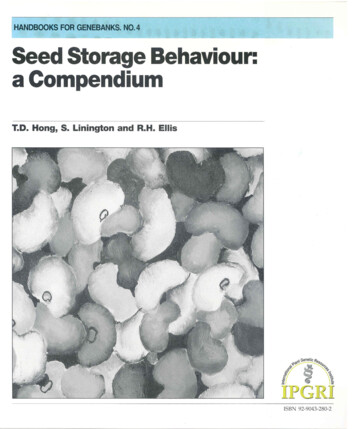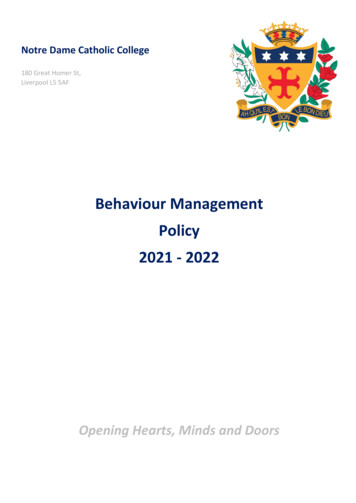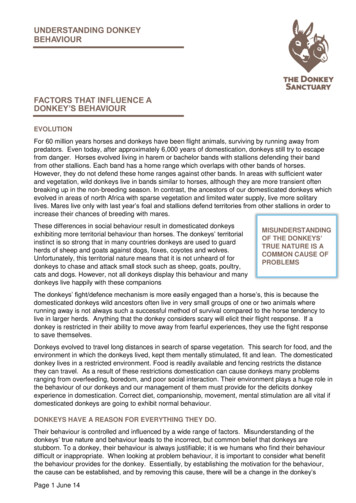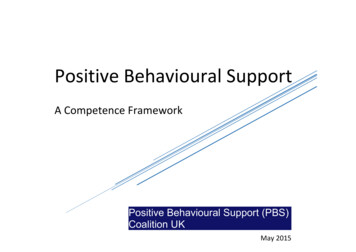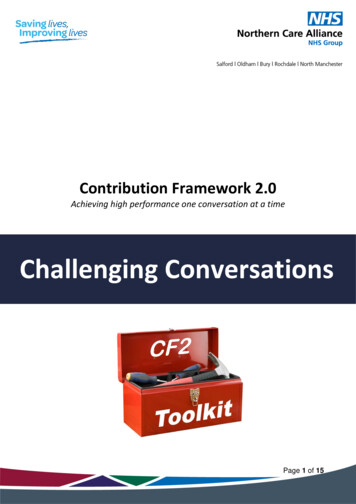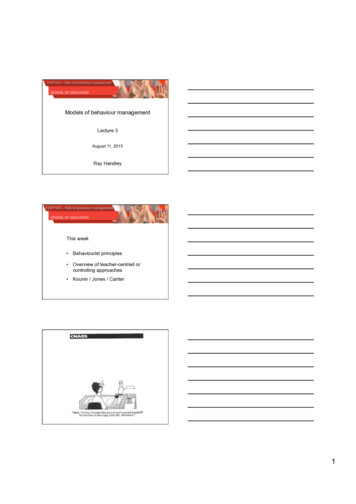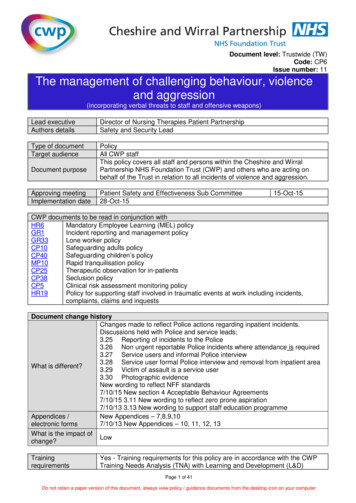
Transcription
Document level: Trustwide (TW)Code: CP6Issue number: 11The management of challenging behaviour, violenceand aggression(incorporating verbal threats to staff and offensive weapons)Lead executiveAuthors detailsDirector of Nursing Therapies Patient PartnershipSafety and Security LeadType of documentTarget audiencePolicyAll CWP staffThis policy covers all staff and persons within the Cheshire and WirralPartnership NHS Foundation Trust (CWP) and others who are acting onbehalf of the Trust in relation to all incidents of violence and aggression.Document purposeApproving meetingImplementation datePatient Safety and Effectiveness Sub Committee28-Oct-1515-Oct-15CWP documents to be read in conjunction withHR6Mandatory Employee Learning (MEL) policyGR1Incident reporting and management policyLone worker policyGR33Safeguarding adults policyCP10Safeguarding children’s policyCP40Rapid tranquilisation policyMP10Therapeutic observation for in-patientsCP25Seclusion policyCP38Clinical risk assessment monitoring policyCP5HR19Policy for supporting staff involved in traumatic events at work including incidents,complaints, claims and inquestsDocument change historyChanges made to reflect Police actions regarding inpatient incidents.Discussions held with Police and service leads;3.25 Reporting of incidents to the Police3.26 Non urgent reportable Police incidents where attendance is required3.27 Service users and informal Police interview3.28 Service user formal Police interview and removal from inpatient areaWhat is different?3.29 Victim of assault is a service user3.30 Photographic evidenceNew wording to reflect NFF standards7/10/15 New section 4 Acceptable Behaviour Agreements7/10/15 3.11 New wording to reflect zero prone aspiration7/10/13 3.13 New wording to support staff education programmeAppendices /New Appendices – 7,8,9,107/10/13 New Appendices – 10, 11, 12, 13electronic formsWhat is the impact ofLowchange?TrainingrequirementsYes - Training requirements for this policy are in accordance with the CWPTraining Needs Analysis (TNA) with Learning and Development (L&D)Page 1 of 41Do not retain a paper version of this document, always view policy / guidance documents from the desktop icon on your computer
Financial resourceimplicationsNoExternal references1. Crime and Disorder Act, 1982 (revised 2010)2. BILD Code of Practice for minimising the use of restrictive physical interventions: planning,developing and delivering training (2014)3. Physical Interventions Fact Sheet, 2003 - British Institute for Learning Disabilities4. National Audit of the Management of Violent People with Learning Disabilities, (2007) - RoyalCollege of Psychiatrists5. Management of Imminent Violence Guidelines 2002 - Royal College of Psychiatrists6. Restraint revisited - rights, risk and responsibility, 2004 - Royal College of Nursing7. Restraining, holding and containing children and young people, 2002 - Royal College of Nursing8. NICE Clinical Practice Guidelines for the Short-term Management of Disturbed/Violent Behaviourin Adult Psychiatric In-patient Settings and Accident and Emergency Settings, March 2005 9. Mental Health Act ‘Code of Practice, 1983 (revised 2008) - Mental Health Act10. Code of Professional Conduct, 2002 - Nursing and Midwifery Council11. Developing Positive Practice to Support the Safe and Therapeutic Management of Aggressionand Violence in Mental Health In-patient Settings, 2004 - National Institute for Mental Health inEngland12. Guidance for Restrictive Physical Interventions: How to provide safe services for people withLearning Difficulties and Autistic Spectrum Disorder, 2002 - Department of Health13. Offensive Weapons, 2006 - NHS Security Management Service14. Safe and Secure (sure) - NHS CFSMS (2005)14. The Mental Capacity Act 2005 (Revised 2009)Equality Impact Assessment (EIA) - Initial assessmentYes/No CommentsDoes this document affect one group less or more favourably than another on the basis of:- RaceNo- Ethnic origins (including gypsies and travellers)No- NationalityNo- GenderNo- CultureNo- Religion or beliefNo- Sexual orientation including lesbian, gay and bisexual peopleNo- AgeNo- Disability - learning disabilities, physical disability, sensoryNoimpairment and mental health problemsIs there any evidence that some groups are affected differently?NoIf you have identified potential discrimination, are there any exceptions valid, legal and/or justifiable?Is the impact of the document likely to be negative?No- If so can the impact be avoided?N/A- What alternatives are there to achieving the document withoutN/Athe impact?- Can we reduce the impact by taking different action?N/AWhere an adverse or negative impact on equality group(s) has been identified during the initialscreening process a full EIA assessment should be conducted.If you have identified a potential discriminatory impact of this procedural document, please refer it tothe human resource department together with any suggestions as to the action required to avoid /reduce this impact. For advice in respect of answering the above questions, please contact thehuman resource department.Was a full impact assessment required?YesWhat is the level of impact?LowPage 2 of 41Do not retain a paper version of this document, always view policy / guidance documents from the desktop icon on your computer
ContentFlowchart 1 – Restrictive intervention pathway . 5Flowchart 2 – Acceptable Behaviour Agreements. .64.74.84.95.Introduction .8Definitions .8Procedure for managing challenging behaviour. 9How the organisation monitors incidents of challenging behaviour . 9How the organisation carries out risk assessments for the prevention and management ofchallenging behaviour .9What is a the Care Programme Approach [CPA] . 10How the organisation uses the framework of the challenging behaviour pathway . 10How Care Plans, that includes support for behaviour that challenges/behavioural support plan,are assessed, developed, reviewed including transfer or discharge of the service user . 10Involvement of Service users and their families . 12Incident management framework . 12Safe Physical Restraint Care Bundle Checklist . 12Environmental review . 12Restrictive physical intervention principles . 12Physical intervention essential key points. 14Monitoring of physical observations . 14Post incident Datix reporting. 14Restrictive interventions and pregnant service users . 15Physical interventions flowchart. 15Post incident support . 15Observations of service users post incident. 16Seclusion and Segregation. 16Mechanical restraint . 16Equality and diversity . 17Arrangements for ensuring the safety of lone workers . 17Student nurses . 17Personal Protection Equipment (PPE) . 17Safeguarding incidents . 17Threats / verbal assault . 17Challenging behaviour and non-service user perpetrators . 18Reporting of incidents to the Police . 18Non urgent reportable Police incidents where attendance is required. 18Service users and informal Police interview . 18Service user formal Police interview and removal from inpatient area . 19Victim of assault is a service user. 19Photographic evidence . 19Offensive weapons. . 19Acceptable Behaviour Agreements . 19Definitions . 20Procedure . 20Factors to consider . 20Verbal Warnings Stage 1. 21Acceptable Behaviour Agreements Stage 2 . 22Monitoring of Acceptable Behavior Agreement . 23Written Final Warning Stage 3 . 23Withdrawal of treatment Stage 4 . 23Restriction of access to CWP premises . 24How the organisation trains staff, in line with the training needs analysis . 24Appendix 1 - Challenging behaviour pathway for the development of care plans. . 25Appendix 2 – Reactive Management for an incident of challenging behaviour . 26Page 3 of 41Do not retain a paper version of this document, always view policy / guidance documents from the desktop icon on your computer
Appendix 3 – Safe physical restraint care bundle checklist (for all incidents) . 27Appendix 4 – Primary Secondary and Tertiary strategies . 28Appendix 5 – Physical interventions flowchart . 32Appendix 6 - Threats / verbal assault flowchart. 33Appendix 7 – Reporting of assault incidents to the Police . 34Appendix 8 - Clinical staff incident report (capacity report). 35Appendix 10 - Examples of the types of incident that may warrant a marker . 38Appendix 11 – Acceptable Behaviour Agreement Stage 2 . 39Appendix 12 – Acceptable Behaviour Agreement - Stage 3 . 40Appendix 13 – Acceptable Behaviour Agreement - Stage 4 . 41Page 4 of 41Do not retain a paper version of this document, always view from the website www.cwp.nhs.uk to ensure it is the correct version
Flowchart 1 – Restrictive intervention pathwayRISK EVENTNIC TO ASSESSREFER TO CARENOTESPREVIOUS HISTORIES?CARE PLAN IN PLACE?NODE-ESCALATIONDEFUSION TECHNIQUESATTEMPTED?OUTCOMEPHYSICAL RESTRAINT NEEDED?(LEAST RESTRICTIVE, NECESSARY, BESTINTEREST)NOYESSUCCESSFUL INTERACTIONYESYESTHERAPEUTIC HOLDINGUSE LEAST RESTRICTIVE HOLDSNO PRONE HOLDINGSERVICE USER PREFERENCESTAFF AVAILABLECONTINUE TO VERBALLY ENGAGECONTINUE TO DEESCALATEVERBALOBSERVE & ASSESSREVIEW OBSERVATION LEVELSREASSURE & SUPPORT SERVICEUSERSUCCESSFULINTERACTIONPOST INCIDENTREVIEW INCIDENT WITH SERVICE USERDEVELOP LEARNING INTO CARE PLANREVIEW EXISTING CARE PLANREVIEW CARSOCOMPLETE DATIX FORMYESNOCONTINUE TO DEESCALATEVERBAL ENGAGEOBSERVE & ASSESSREASSURE & SUPPORT SERVICEUSERRELOCATE TO SAFER AREA?SECLUSION?PRINCIPLES OFCARELEAST RESTRICTIVE NECESSARYBEST INTERESTNECESSARYPROPORTIONATENOTIFYDUTY MEDICBLEEP HOLDER/MMCLINICAL PROCESSIN ACCORDANCE WITH CWP CP6CHALLENGING BEHAVIOUR POLICYPage 5 of 41Do not retain a paper version of this document, always view from the website www.cwp.nhs.uk to ensure it is the correct version
Flowchart 2 – Acceptable Behaviour AgreementsSTAGE 1INITIAL WARNINGLETTERNON-PHYSICAL VIOLENTOR AGGRESSIVEINCIDENT OCCURSRESPONSIBLE CLINICIAN/CONSULTANTARRANGES MEETINGWITH SERVICE USER AND/OR NEAREST RELATIVETO DISCUSS INCIDENTAND AGREED ACTION TOPROMOTE SAFETY OF ALLSTAGE 2FINAL WARNING LETTERVERBAL VIOLENT ORAGGRESSIVE INCIDENTCONTINUESSTAGE 3RESTRICTION OF ACCESSTO HEALTH SERVICESVERBAL VIOLENT ORAGGRESSIVE INCIDENTCONTINUESCLINICAL STAFF ISSUE VERBALWARNING AND RECORDED INTOSERVICE USERS ELECTRONICRECORDSVIOLENT OR AGGRESSIVEINCIDENT CONTINUESRESPONSIBLE CLINICIAN/CONSULTANT DISCUSSESINCIDENT AT NEXT CARE TEAMMEETING- AGREES DATE FOR REVIEW OFABA LETTER- RECORDS ALL IN THEINDIVIDUALS ELECTRONICRECORDSSENIOR CLINICAL LEAD; ISSUES FIRST ABALETTER TO SERVICE USEROR INDIVIDUAL- RECORDS INTOELECTRONIC RECORDS- NOTIFIES RESPONSIBLECLINICIAN/ CONSULTANTCSU GENERAL MANAGER ORDEPUTY;- ISSUES FINAL WARNING LETTER- MEETS WITH SERVICE USERAND/OR INDIVIDUAL TO DISCUSSINCIDENT- AGREES REVIEW DATE WITHSERVICE USER AND/ORINDIVIDUALCLINICAL LEAD INFORMSRESPONSIBLE CLINICIAN/CONSULTANT AT EARLIESTOPPORTUNITY&ENSURES INCIDENT ISREPORTED TO THE POLICEWITH A VIEW TO SEEKINGPROSECUTIONCLINICAL LEAD INFORMSRESPONSIBLE CLINICIAN/CONSULTANTAT NEXT CARE TEAMMEETINGRESPONSIBLE CLINICIAN/CONSULTANT ARRANGESMDT/HEALTHPROFESSIONALS MEETING(GP/POLICE/ LSMS) TODISCUSS ASSOCIATED RISKSAND ISSUES RELATED TORESTRICTION OF ACCESS TOHEALTH SERVICES&AGREE PLANCLINICAL LEAD INVESTIGATES AREPORTED INCIDENT&ASSESSES THE RISK OFVIOLENCE TO STAFFDECISION TO ISSUE STAGE 1ACCEPTABLE BEHAVIOURAGREEMENTSENIOR CLINICAL LEAD AMENDSCARENOTES WITH INCIDENTDETAILSRESPONSIBLE CLINICIAN/ CONSULTANT DISCUSSES INCIDENT AT NEXT CARE TEAMMEETING:- AGREES DATE FOR REVIEW OF ABA LETTER- RECORDS ALL IN THE INDIVIDUALSELECTRONIC RECORDS- DISCUSSES INCIDENT WITH SERVICE USERAND/OR NEAREST RELATIVE- INFORM SERVICE USER GPMEDICALWITHDRAWAL ORRESTRICTION OF HEALTHSERVICES?DIRECTOR OF NURSINGOR CEO TO SIGN ANDSEND STAGE 3 LETTEROUTLINING AGREED PLANAND DETAILS OF HOW TOAPPEALCLINICALCWP EXECSPage 6 of 41Do not retain a paper version of this document, always view from the website www.cwp.nhs.uk to ensure it is the correct version
Challenging Behaviour statement of intentDefinition: ‘Behaviour can be described as challenging when it is of such an intensity, frequency, orduration as to threaten the quality of life and/or the physical safety of the individual or others and it islikely to lead to responses that are restrictive’ [Emerson, 1995]1. All service users will be supported to exercise their human rights (which are the same as everyoneelse’s) to be healthy, full and valued members of their community with respect for their culture,ethnic origin, religion, age, gender, sexuality and disability.2. All service users who are at risk of presenting behavioural challenges will have their needsassessed and identified at the earliest possible opportunity, leading to the development of anagreed co-ordinated behavioural support plan which will be continually monitored and reviewedthroughout their care episode by the service user and the care team.3. All behavioural support plans will be individualised and developed on the basis of a detailedunderstanding of the service users support needs which will include their communication needs.These plans will be individually-tailored, flexible, and responsive to changes in individualcircumstances and delivered in the most appropriate local environment.4. Service users will be supported by clinical services that will create or provide appropriateenvironments for their individual recovery.5. A person centred approach will be taken that enables positive risk taking to ensure that all serviceusers have access to family, social life and leisure.6. Service users will not intentionally be hurt, damaged or humiliated in any way by interventions oractions. All privacy and dignity needs will be prioritised at all times by staff.7. Throughout any incident of challenging behaviour service users will be supported to have a goodquality of life by staff who hold the right values, attitudes, training and experience8. All services will seek to reduce the use of physical intervention, seclusion and promote appropriateuse of medication for each service user through use of appropriate de-escalation, active listeningand ensuring that service users are proactively involved in the planning, implementing andmonitoring of all care/support provided.9. All restrictive interventions used to manage challenging behaviour will be for the shortest timepossible, be the least restrictive intervention, proportionate to the risk posed and in the serviceusers best interest.10. Post incident all service users will be offered support and feedback by their care team to betterunderstand individual incident analysis through active involvement in the incident review process.Page 7 of 41Do not retain a paper version of this document, always view from the website www.cwp.nhs.uk to ensure it is the correct version
1.IntroductionThis policy is intended to cover all staff and service users and members of the public and others inrelation to the management of challenging behaviour incidents. This can be defined as “protectingpeople and property, so that the highest standard of clinical care can be given to service users”. CWPwill not tolerate acts of violence against its service users or members of staff and will ensure thatsystems are in place to review and report such incidents in accordance with the legal and professionallaw. The policy reflects the national guidance from the NHS Protect who has the remit ofencompassing all policy and operational responsibility for the management of security within the NHS(Statutory Instrument 3039/2002). This document complies with NHSLA Risk Management Standard4, Criterion 2; Violence and Aggression.Within this policy the term challenging behaviour is intended to refer to a spectrum ofbehaviours which may be involved within incidents such as violence and aggression whichcan occur within any of its inpatient and/or community settings. Also within this policy theterm Care Plan also refers to a set of documented planned interventions which includeBehavioural Support Plans used in Learning Disabilities and Treatment Plans.The policy sets out a framework of good practice, recognising the need to ensure that all legal, ethicaland professional issues have been considered when managing incidents of challenging behaviour.Where challenging behaviour is identified as arising from clinical factors the full involvement of theservice user or nearest relative/advocate must occur in the clinical decision making process. The aimis to support staff and service users to promote safer environments and ensuring effective responsesin potential or actual difficult situations through agreed pathways. This policy also ensures compliancewith the regulatory standards for all staff when using interventions which may be deemed as restrictiveand ensures all interventions are in the best interests of the service user and use least restrictiveprinciples and proportionate to the risk posed.This policy was developed with guidance from the British Institute of Learning Difficulties (BILD)Positive Behavioural Support Interventions which refers to a set of approaches which are recognisedas the most appropriate when supporting people with intellectual disabilities who present withchallenging behaviour.2.DefinitionsAggression - Any behaviour that is perceived by the victim as being deliberately harmful or damagingeither psychologically or physically [Health and Safety Executive 1999]Challenging Behaviour - Behaviour can be described as challenging when it is of such an intensity,frequency, or duration as to threaten the quality of life and/or the physical safety of the individual orothers and it is likely to lead to responses that are restrictive’ [Emerson, 1995]Common Assault - Is committed by a person who causes another person to apprehend theimmediate use of unlawful violence, [Criminal Justice Act 1988].De-escalation - A set of non-physical interventions intended to reduce a person’s heightened state ofarousal and also reduce the risk of harm to self, others and the environmentOffensive Weapons -‘Offensive weapon’ means any article made or adapted for use for causinginjury to the person, or intended by the person having it with him for use such as by him or by someother person’. [Prevention of Crime Act 1953]Physical Violence - ‘The intentional application of force against the person of another without legaljustification resulting in physical injury or personal discomfort’ [NHS Protect 2011]Page 8 of 41Do not retain a paper version of this document, always view from the website www.cwp.nhs.uk to ensure it is the correct version
Prone position - A body position in which one lies flat with the chest down and back upRestraint –states ‘Physical restraint refers to any direct physical contact where the intention is toprevent, restrict, or subdue movement of the body (or part of the body) of another person’ [MHA Codeof Practice 2015]Section of the Mental Capacity Act [2005] 6[4] of the Act states that someone is using restraint if they;use force – or threaten to use force – to make someone do something that they are resisting, or torestrict a person’s freedom of movement, whether they are resisting or notVerbal Assault - The use of inappropriate words or behaviour, causing distress and / or constituting toharassment’ [NHS Security Management Service 2007]3.Procedure for managing challenging behaviourChallenging behaviour is seen as being very emotionally demanding for both service users and staffand adopting the correct practice can benefit everyone concerned to enhance safe environments andpromote recovery. This is with the emphasis on understanding and managing the environment arounda service user to promote personal choice and control with full inclusion as a valued team member inthe decision making process. To achieve these objectives this policy sets out a framework ofinterventions which can be implemented based on using the least restrictive actions, proportionate tothe risk posed, promoting autonomy and responsibility at the earliest opportunity.It is important to note that these interventions are designed as a guide to support clinical decisionmaking, not to replace it. If the service user’s clinical needs do not fit with the guidance, then thatservice users’ needs must come first. In all cases the judgment of the Multi-Disciplinary Team (MDT)supporting the client to realise their potential will always take priority.3.1How the organisation monitors incidents of challenging behaviourIn line with the requirements and guidance of MHA Code of Practice the Trust information isaggregated and presented within the Trust Learning from Experience (LfE) report which is received bythe Board and Quality Committee, three times per year. In addition the Trust also monitors adherencewith identified key standards of this policy as part of its Inpatient Safety Metric programme which isundertaken every two months and reported to the Board as part of Quality reporting.3.2How the organisation carries out risk assessments for the prevention and managementof challenging behaviourAll service users must be assessed for the risk of behaviour(s) which may result in an injury tothemselves or others on admission; or on referral to services (including community) and following anyepisode of change to previously identified risk. The risk assessment tools approved for use arecontained in the CP5 Clinical risk assessment policy.Staff must be alert to risks that may not be immediately apparent, such as self-neglect. Assessmentsshould take account of the person’s history of such behaviours, their history of experiencing personaltrauma, their presenting mental and physical state and their current social circumstances. Whileprevious history is an important factor in assessing current risk, staff should not assume that aprevious history of behavioural disturbance means that a person will necessarily behave in the sameway in the future.Assessments of behavioural presentation are important in understanding an individual’s needs. Theseshould take account of the individual’s social and physical environment and the broader contextagainst which behavioural disturbance occur.There may be times where an individual feels angry for reasons not associated with their mentaldisorder and this may be expressed as behavioural disturbance.Page 9 of 41Do not retain a paper version of this document, always view from the website www.cwp.nhs.uk to ensure it is the correct version
Assessments should seek to understand behaviour in its broader context and not presume it to be amanifestation of a mental disorder.Assessments should consider the views of patients and their families, carers and advocates aboutwhy an individual might be behaving in a particular way, including any historical accounts of behaviourand possible reasons for that behaviour. This is particularly important because they can provide usefulinsights regarding individual responses to behavioural that have been tried in the past.The results of the assessment should guide the development and implementation of effective,personalised and enduring systems of support that meet an individual’s needs, promote recovery andenhance quality of life outcomes for the individual and others who care and support them.All completed risk assessments will be retained in the service users care records and the summarisedview of risk updated, monitored and followed up by the responsible clinical team at care meetingsand/or locally by the nursing team following an incident or any change in the risk.3.3What is a the Care Programme Approach [CPA]The CPA is an overarching system for coordinating the care of people with mental disorders. Itrequires close engagement with service users and their carers and includes arrangements forassessing, planning and reviewing care. Central to Care Programme Approach [CPA] is the CPA careplan which aims to ensure a transparent, accountable and coordinated approach to meeting wideranging physical, psychological, emotional and social needs which are associated with a person’smental disorder.3.4How the organisation uses the framework of the challenging behaviour pathwayThe challenging behaviour pathway is a clinical framework to guide and support staff to provide safeand effective care. Following the risk assessment process and/or incident of challenging behaviour anindividualised care plan will be formulated which will highlight the clinical problem and actions requiredto minimise the risk.3.5How Care Plans, that includes support for behaviour that challenges/behaviouralsupport plan, are assessed, developed, reviewed including transfer or discharge of the serviceuser (see appendix 1)Care Plans must take account of disabilities, a service users level of cognitive functioning, the impactof age in terms of physiological and emotional maturity, the service users ethnicity, culture, religion orbelief, gender, gender identity and sexual identity. They must also take into account and maximise theservice users privacy a
10. Code of Professional Conduct, 2002 - Nursing and Midwifery Council 11. Developing Positive Practice to Support the Safe and Therapeutic Management of Aggression and Violence in Mental Health In-patient Settings, 2004 - National Institute for Mental Health in . MDT/HEALTH PROFESSIONALS MEETING (GP/POLICE/ LSMS) TO DISCUSS ASSOCIATED RISKS .




